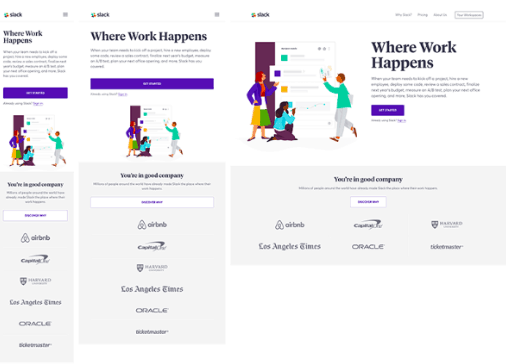The rule of thumb for success in any business is to be where your audience is, provide value, and continuously adapt to change.
For tech and service-based companies, those commandments can be modified slightly: Be where your users are, build things they want, and not only adapt to change, but get ahead of it!
This may all sound clichéd, but following these simple rules is what has ensured the growth and success of companies since the beginning of time.
Take, for example, Nokia. We all know the company as a smartphone manufacturer, but did you know that Nokia was originally a pulp and paper company in the 1860s?
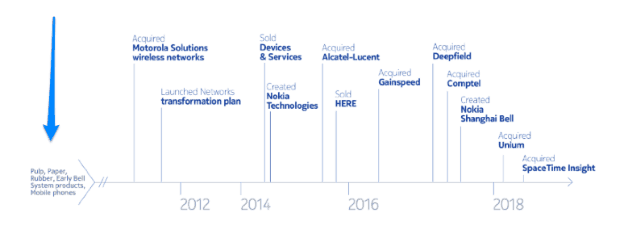
Another example in the tech field is PayPal, which was first envisioned as a cryptography company but later went on to become the online payment portal used by millions.
While these two examples are multimillion-dollar tech companies, the importance of adaptability holds true for new-age SaaS startups too, where shelf life is short and the recall value of products is very small.
The truth is, if organizations don’t evolve, they’ll die. You cannot simply stand still—you either keep the pace or fall behind.
Venture capitalist Paul Graham puts it this way in an article about fatal startup mistakes:
“The stick-to-your-vision approach works for something like winning an Olympic gold medal, where the problem is well-defined. Startups are more like science, where you need to follow the trail wherever it leads.”
For SaaS startups, this means adopting a mobile-first approach.
Why Mobile Matters
At the 2010 Mobile World Congress in Barcelona, Eric Schmidt, then CEO of Google, urged application developers to focus on mobile rather than desktop experiences.
The most significant takeaway from this talk was his take on the future of mobile:
“This is the time for us, now is the time for us to get behind this. … We understand that the new rule is mobile first.”
Remember, this was back in 2010.
Fast forward to 2018 and a LOT has changed in the mobile space—from both a technological and usage standpoint. These changes have strengthened the role of mobile and businesses realize that not adopting a mobile-first approach will impact their growth negatively.
We are sure you’ll agree.
Now here’s the thing about a mobile-first approach: It may mean different things for different SaaS companies.
Let us explain this further.
Essentially, a mobile-first approach includes both apps and mobile-responsive sites as part of the overall strategy. When it comes to SaaS companies, a mobile-responsive website is a given—it is standard practice to offer a site that’s readable and functional on any mobile device.
Here’s what Slack’s site looks like across three different devices:
And while a responsive website is still important for SaaS startups, apps have recently taken center stage in mobile-first strategy.
Is The Future of Mobile App-Driven?
Without a time machine we can’t say for certain, but yes, it seems like it.
The demand for mobile apps is constantly rising. According to App Annie, smartphone users are using 9 apps per day and 30 apps a month, on average.

Mobile apps are so intertwined in the average user’s daily life that not offering the same experience for their business needs is shooting yourself in the foot, whether you’re a B2C or B2B company.
And you’re up against stiff competition: Both Android and iOS users have the choice of around 2 million apps, a Statista reports says.
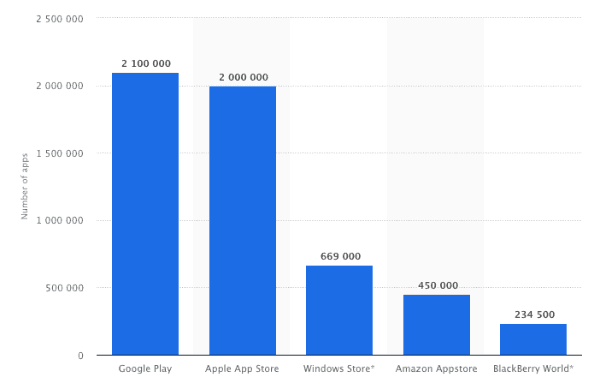
Chances are that if your audience can’t find an app from you, they’ll download one from a competitor!
That being said, should a SaaS business launch an app just because everyone else is?
Not at all. In fact, any company’s decision to roll out a mobile app should be based on the overall benefits that an app could bring to their business, especially when compared to a mobile-responsive site.
Recent reports reveal how mobile apps are helping companies gain visibility, boost engagement and conversions, and facilitate interaction with their users at all levels of the purchase funnel.
Let’s look at these statistics:
- People view 4.2x more products per session within apps than on mobile sites
- Apps have 3x higher conversion rates than mobile sites
- For every second of delay in mobile page load, conversions can fall by up to 20%
Despite knowing the benefits, it’s still a big decision for any business to launch an app, given that there are a lot of moving pieces when shifting from web to mobile.
For a few startups the shift may be easy, but for others, it will be an uphill task. Even tech giants like Facebook encountered challenges when going mobile. In an interview with First Round, Facebook’s former product leader SC Moatti said:
“Mobile has an entirely different resonance and cadence for users, which makes the development of mobile apps fundamentally different too.”
She added:
“Native apps are not nearly as flexible and fixable as websites. From a user perspective, because people are more emotional about their phones, you can break trust, you can turn people off, and they don’t come back as easily—or ever. If the cost of an error on web is 1X, the cost of a similar error on mobile is 10X.”
SaaS Edition: What Typeform, Hotjar, and Duolingo Can Teach Us About Mobile App Adoption
Often, the best way to learn is to follow the lessons of those that have come before us. That said, the startups mentioned in this section can teach us three things:
- Your app idea may work
- Your app idea will require planning
- Your app will require a lot of work
Let’s dive in and explore the opportunities and challenges these SaaS startups faced while going mobile—what worked for them, and what did not.
Typeform: The Story of a Winning App
If you are a marketer and love creating forms, chances are you already know Typeform. If not, Typeform is a tool that helps create beautiful and interactive forms for personal and business use.
When this SaaS startup adopted a mobile strategy, the decision was driven by its users’ needs. The tool was amazing on the web, but in their own words was “missing in action” when it came to handheld devices.
Why did the company decide to add an app to its product offering?
The team had seen huge spikes in its mobile signups, surpassing the number of desktop signups. But without a mobile product, all they could do was point those people toward their desktop tool. The company realized that there was indeed a product gap that needed to be filled ASAP.
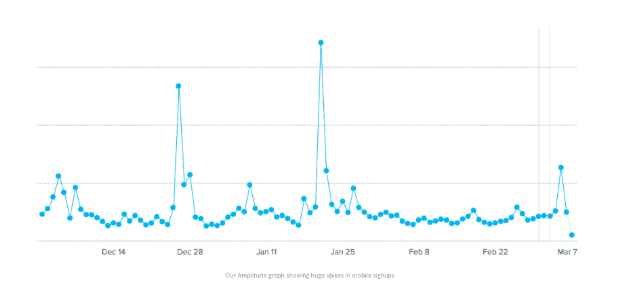
Their approach?
“People wanted mobile. So by building something fast, we could test that assumption to see if it was true. The race was on. Make something straightforward and simple that could satisfy our users—and not waste all that beautiful mobile traffic.”
The end result is the Typeform Lite app, which was launched in three short months. The app has not only filled the product gap but has successfully provided the same engaging experience as their web tool. We aren’t just saying that—the proof is in the pudding.
Hotjar: The Story of a Failed App
Many of us recognize Hotjar as one of the top voted all-in-one analytics and feedback tools. Despite being a web-heavy tool, the company decided to launch a mobile app.

Their reasons? Not very different from Typeform’s. But unlike the team at Typeform, which based their decision on hard-hitting data, the team at Hotjar went ahead based on a gut feeling, running a project they thought was a good idea without actually validating it with their users.
“We skipped this step with the app, and wasted a lot of time on a project that took months to build, and months to fail.”
With no data backing their decision, the team ended up creating an app that was lacking the key features present in their web offering.
“Users mostly wanted to view recordings on mobile. But guess what? Because the tech that lets people watch Recordings in a web browser doesn’t work at all on mobile, we figured ‘let’s just scrap recordings and focus on the rest’. Yes: the one thing people might have wanted was the one thing we didn’t do.”
Did they learn a lesson the hard way? Yes indeed.
“Our customer validation process now ensures that we don’t waste time or money chasing ideas we think are good. We know they’re good and they’ll only get better—because they came from our customers.”
One insight to take away from this example is that companies should invest enough time in research and planning before they set out to launch an app.
Duolingo: The Story of a Successful App
When you launch a mobile app, you have to continue to offer value and an elevated experience to your users.
Why’s that important?
Because if you don’t meet their expectations, your app will be deleted. Users have no shortage of potential apps to download, so they can afford to be picky. In fact, 21% of users delete an app after one use, according to Localytics.
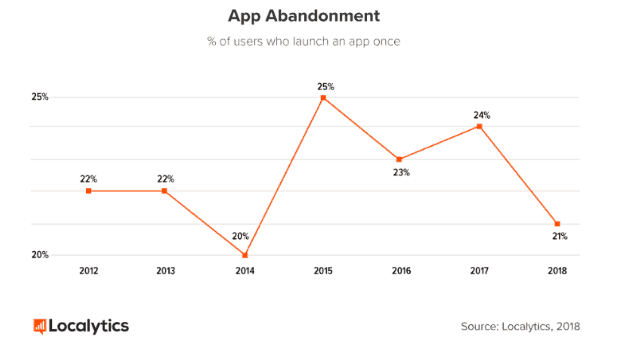
Unfortunately, most SaaS startups ignore this advice while building an app, but not Duolingo, a mobile-first startup that helps people learn new languages. Duolingo’s team realized the significance of testing early on, which helped the team scale from 30 million users to 200 million in a short period of time.
The team continuously runs A/B tests in order to adapt to their users’ changing needs. Though crucial for keeping customers happy, testing can also slowly draw you away from aspects of the user experience that are central to your brand, or so says Duolingo’s ex-growth manager, Gina Gotthilf:
“It’s easy to slip imperceptibly with each experiment. There must be areas where you won’t compromise.”
In other words, while testing can give you insights you need to make positive changes, not all changes are worth it if you have to sacrifice other key areas of operation.
Bringing It All Together
The world of SaaS is ever-evolving—companies have to move fast to stay relevant. Keeping up requires a new way of thinking, and that’s prioritizing mobile and mobile apps. Before you decide that a mobile-first approach is not for you, take a look around.
Yes, it is hard work and, yes, it requires thinking outside the box, but unless you experiment, take chances and cater to your users’ growing appetite for mobile, you’ll never reach the growth milestones that you’ve envisioned for your startup.
The debate should not be about whether you want to go the mobile way; it should be about how early you can jump on the bandwagon. Because if you’re late, you’re going to miss the party. The market is ripe and your customers are ready, so what are you waiting for? It’s time to go get them!
Are you a SaaS startup with a focus on mobile? What have you learned thus far? Share with us in the comments.
Ready to start building your app? Check out The Definitive Guide To Launching An App Right & Generating Traction, where we dive into planning an app, wireframing an app, researching your customers, UX testing, prototyping, launch strategies and much more!

